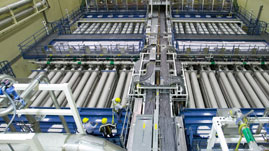Teachers' Domain - Digital Media for the Classroom and Professional Development
User: Preview


Source: NewsHour: California Scientists Advance Toward Producing Fusion Energy, March 17, 2009



In this report from the NewsHour, correspondent Spencer Michels reports on ongoing efforts to produce fusion energy to help fuel American energy independence.
This video includes interviews with scientists at the Lawrence Livermore National Lab in California and an animation of fusion.
After years of setbacks and delays, Lawrence Livermore National Laboratory in California has just completed a $4 billion laser — the highest-power, most-precision flexible laser that has ever been built.
Scientists hope to use the laser to produce fusion energy — the energy produced when pieces of mass are fused together at very high temperatures — a goal researchers have been working towards for decades.
"Fusion energy is the long-term solution. It is infinite — essentially infinite fuel and it has no carbon waste," says Ed Moses, a Lawrence Livermore scientist.
Fusion energy is produced in the sun's core, for example when smaller hydrogen nuclei are fused together to create a larger helium nucleus. Scientists also use fusion energy in hydrogen bombs. But creating it in a controlled way in the lab won't be easy. The Livermore scientists plan to aim the precision laser at a tiny ball of hydrogen isotopes the size of a pill. The collisions that take place inside the sphere will produce fusion energy.
But researchers are divided over whether the new research facility will be able to produce more energy than it uses.
Ed Moses says he believes there will be fusion power plants up and running in a dozen years, but Richard Muller, a physicist at the University of California Berkeley, is more doubtful. "We're not there yet," Muller says. "Right now, we have to find a cheap way to do this, a reliable way. And so far we're just trying to make it work. I think of it as building the first gasoline engine."
 Loading Standards
Loading Standards